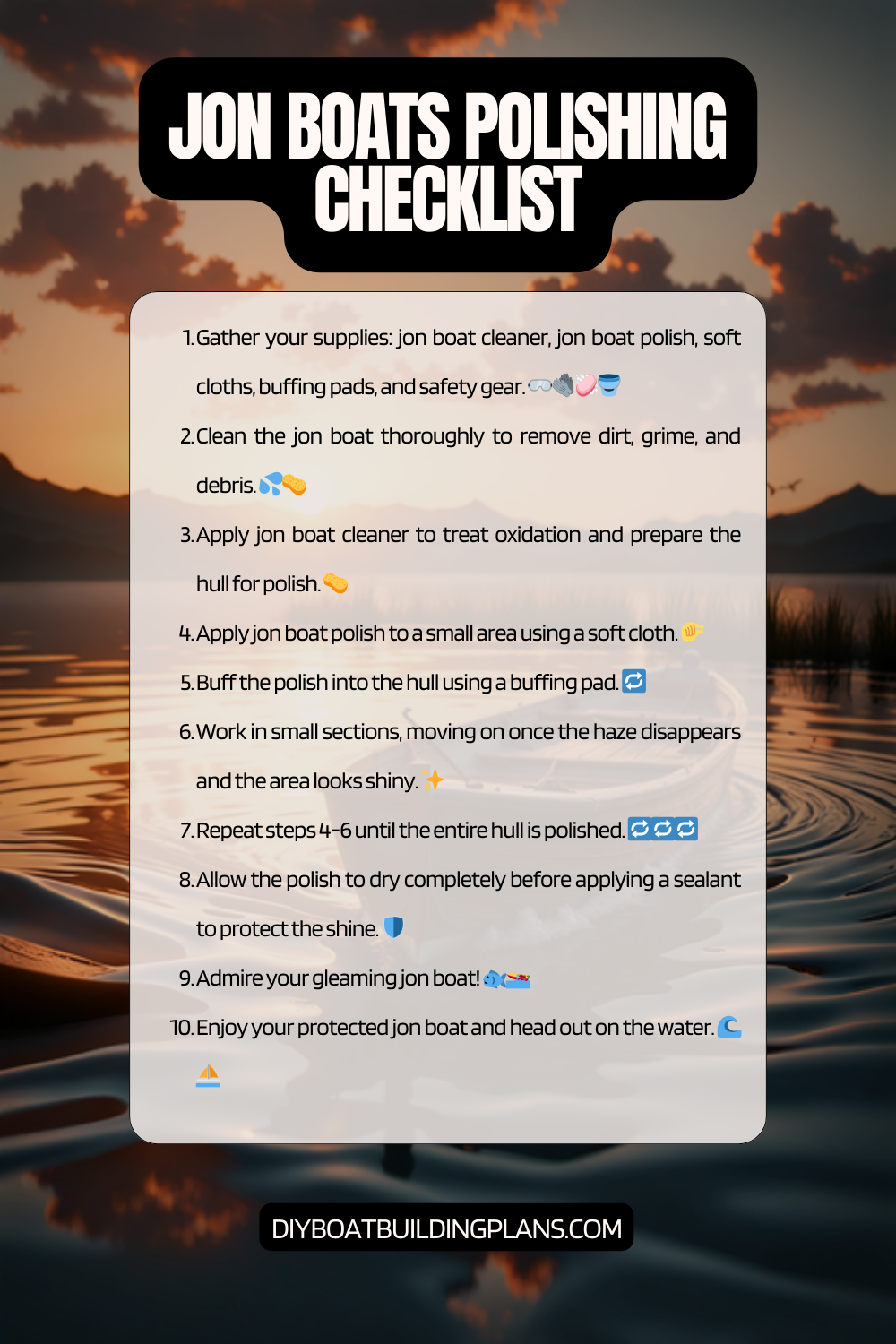Overview of Jon Boat Polishing Tips
Jon Boat Polishing is the process of restoring and maintaining the appearance of your Jon Boat. A Jon Boat is a flat-bottomed boat that is commonly used for fishing and hunting in shallow waters. Over time, the exterior of your Jon Boat can become dull and faded due to exposure to harsh weather conditions, UV rays, and general wear and tear. Polishing your Jon Boat not only enhances its aesthetic appeal but also provides protection against rust, corrosion, and other damages.
Maintaining the appearance of your Jon Boat is essential for several reasons. Firstly, a well-maintained boat reflects your pride of ownership and attention to detail. It creates a positive impression on others and adds value to your investment. Secondly, a polished boat is more resistant to the damaging effects of the elements. By regularly polishing your Jon Boat, you can extend its lifespan and ensure that it remains in top condition for years to come.
Key Takeaways
- Polishing your Jon Boat is important to maintain its appearance and protect it from damage.
- Materials needed for Jon Boat polishing include a buffer, polishing compound, and microfiber towels.
- Follow a step-by-step guide to polish your Jon Boat, starting with cleaning and ending with a protective coating.
- Choose the right polish for your Jon Boat based on its material and level of oxidation.
- Hiring a professional for Jon Boat polishing can save time and ensure a high-quality finish.

Importance of Polishing Your Jon Boat
One of the primary reasons for polishing your Jon Boat is to protect it against harsh weather conditions. Exposure to sunlight, rain, and saltwater can cause the paint or gel coat on your boat to fade and deteriorate over time. By applying a high-quality polish, you create a protective barrier that shields your boat’s surface from these elements. This not only helps maintain its appearance but also prevents costly repairs or repainting in the future.
Another crucial benefit of polishing your Jon Boat is the prevention of rust and corrosion. The metal components of your boat, such as the hull, fittings, and hardware, are susceptible to rust when exposed to moisture. Polishing your boat regularly helps remove any existing oxidation and creates a protective layer that inhibits further corrosion. This is especially important if you frequently use your Jon Boat in saltwater environments where corrosion can occur more rapidly.
Furthermore, polishing your Jon Boat can significantly prolong its lifespan. By regularly removing dirt, grime, and other contaminants from the surface, you prevent them from causing long-term damage. Polishing also helps maintain the structural integrity of your boat by preventing cracks, chips, and other signs of wear. By investing time and effort into polishing your Jon Boat, you can enjoy its functionality and appearance for many years to come.
Materials Needed for Jon Boat Polishing
To effectively polish your Jon Boat, you will need several materials. These include:
1. Boat Polish: Choose a high-quality boat polish specifically designed for the type of material your Jon Boat is made of. There are different polishes available for fiberglass, aluminum, and other boat materials. Ensure that the polish you select provides UV protection and is suitable for marine environments.
2. Microfiber Cloths: Microfiber cloths are ideal for boat polishing as they are soft, lint-free, and do not scratch the surface. Use them for applying and buffing the polish.
3. Polishing Pad or Buffer: If you prefer a faster and more efficient polishing process, consider using a polishing pad or buffer. These tools help distribute the polish evenly and provide a more professional finish.
4. Water Hose or Bucket: You will need water to rinse off any residue or excess polish during the process.
5. Protective Gloves: It is advisable to wear protective gloves to prevent any potential skin irritation from the polish or chemicals used during the process.
6. Masking Tape: If there are areas on your Jon Boat that you want to protect from accidental polish application, use masking tape to cover them.
Each material serves a specific purpose in the Jon Boat polishing process. The boat polish is responsible for restoring shine and protecting the boat’s surface, while microfiber cloths ensure a smooth application and buffing. The polishing pad or buffer helps achieve a more efficient and professional finish. Water is necessary for rinsing off excess polish, and protective gloves safeguard your skin. Masking tape is useful for protecting specific areas from accidental polish application.
Step-by-Step Guide to Polishing Your Jon Boat
| Step | Description |
| 1 | Wash the boat with soap and water |
| 2 | Apply rubbing compound to remove oxidation |
| 3 | Use a buffer to apply polishing compound |
| 4 | Apply wax to protect the boat |
| 5 | Buff the boat to a shine |
| 6 | Clean and polish metal surfaces |
| 7 | Apply vinyl protectant to seats and other vinyl surfaces |
1. Preparation: Before you begin polishing your Jon Boat, ensure that it is clean and free from any dirt, grime, or debris. Use a mild boat cleaner and water to thoroughly wash the boat’s surface. Rinse off the cleaner and allow the boat to dry completely.
2. Masking: If there are any areas on your Jon Boat that you want to protect from accidental polish application, use masking tape to cover them. This could include decals, rubber trim, or any other sensitive areas.
3. Application: Apply a small amount of boat polish onto a microfiber cloth or directly onto the surface of your Jon Boat. Start by working on a small section at a time, applying the polish in circular motions. Ensure even coverage and avoid applying too much pressure.
4. Buffing: Once the polish has been applied, use a clean microfiber cloth to buff the surface in circular motions. This helps remove any excess polish and brings out the shine. Continue buffing until the desired shine is achieved.
5. Repeat: Repeat steps 3 and 4 for each section of your Jon Boat until the entire surface has been polished.
6. Final Touches: After polishing your Jon Boat, remove any masking tape and inspect the boat for any missed spots or areas that require additional attention. Touch up these areas as needed.
7. Rinse: Rinse off any residue or excess polish using a water hose or bucket. Ensure that all traces of polish have been removed.
8. Final Inspection: Once your Jon Boat has dried, inspect it under different lighting conditions to ensure that the polish has been evenly applied and that the desired shine has been achieved.
Tips for achieving the best results:
– Work in small sections to ensure even coverage and prevent the polish from drying too quickly.
– Use a clean microfiber cloth for each section to avoid transferring dirt or residue.
– Apply the polish in a shaded area to prevent it from drying too fast.
– Avoid applying excessive pressure as this can cause swirl marks or damage the boat’s surface.
– Follow the manufacturer’s instructions for the specific boat polish you are using.
Tips for Choosing the Right Polish for Your Jon Boat
When choosing a polish for your Jon Boat, there are several factors to consider. These include the type of material your boat is made of, the desired level of shine, and the specific conditions in which you will be using your boat.
Different types of polishes offer various benefits. For fiberglass boats, choose a polish that is specifically formulated for fiberglass surfaces. These polishes often contain UV inhibitors to protect against sun damage and fading. Aluminum boats require polishes that are designed to remove oxidation and restore shine to the metal surface. Gel coat polishes are suitable for boats with gel coat finishes, providing protection and enhancing the appearance.
Consider the level of shine you want to achieve. Some polishes offer a high-gloss finish, while others provide a more subtle shine. Determine your preference and select a polish accordingly.
Additionally, take into account the conditions in which you will be using your Jon Boat. If you frequently navigate saltwater environments, choose a polish that offers enhanced protection against corrosion and saltwater damage.
It is always recommended to read product reviews and consult with professionals or fellow boat owners to get recommendations on the best polish for your specific Jon Boat.
How Often Should You Polish Your Jon Boat?
The frequency at which you should polish your Jon Boat depends on several factors, including how often you use it, the conditions in which it is stored, and the type of polish used.
As a general guideline, it is advisable to polish your Jon Boat at least once or twice a year. This helps maintain its appearance and provides ongoing protection against the elements. However, if you frequently use your boat or expose it to harsh conditions, you may need to polish it more frequently.
Boats that are stored outdoors or in areas with high levels of UV exposure may require more frequent polishing to prevent fading and damage. Similarly, boats used in saltwater environments should be polished more often to protect against corrosion.
Regularly inspect your Jon Boat’s surface for signs of oxidation, fading, or loss of shine. If you notice any of these issues, it is a good indication that it is time to polish your boat.
Common Mistakes to Avoid When Polishing Your Jon Boat
While polishing your Jon Boat can greatly enhance its appearance, there are some common mistakes that should be avoided to achieve the best results.
1. Using the wrong polish: Using a polish that is not specifically designed for your boat’s material can lead to ineffective results or even damage the surface. Always choose a polish that is suitable for your boat’s material and follow the manufacturer’s instructions.
2. Applying too much pressure: Applying excessive pressure while polishing can cause swirl marks or scratches on the boat’s surface. Use a gentle touch and let the polish do the work.
3. Skipping the preparation step: Properly cleaning and preparing your boat’s surface before polishing is crucial for achieving optimal results. Skipping this step can result in poor adhesion of the polish and an uneven finish.
4. Not buffing enough: Buffing is an essential step in the polishing process as it removes excess polish and brings out the shine. Take the time to thoroughly buff each section of your Jon Boat for a professional finish.
5. Neglecting regular maintenance: Polishing your Jon Boat is just one part of maintaining its appearance. Regular cleaning, waxing, and other maintenance practices are also important for preserving its shine and protecting against damage.
By avoiding these common mistakes, you can ensure that your Jon Boat looks its best and remains in top condition.
How to Maintain the Shine of Your Jon Boat
To maintain the shine of your Jon Boat after polishing, it is essential to follow proper cleaning and maintenance practices. Here are some tips to help you keep your boat looking its best:
1. Regular cleaning: Wash your boat regularly with a mild boat cleaner and water to remove dirt, salt, and other contaminants. Avoid using harsh chemicals or abrasive cleaners that can damage the surface.
2. Rinse after each use: After each outing, rinse your boat with fresh water to remove any saltwater or debris that may have accumulated. This helps prevent corrosion and keeps the boat looking clean.
3. Waxing: In addition to polishing, consider applying a high-quality boat wax to further protect the surface and enhance the shine. Waxing provides an additional layer of protection against UV rays, oxidation, and other environmental factors.
4. Avoid abrasive materials: When cleaning or drying your boat, use soft microfiber cloths or sponges to avoid scratching the surface. Avoid using abrasive materials such as steel wool or harsh brushes.
5. Store properly: When not in use, store your Jon Boat in a covered area or use a boat cover to protect it from the elements. This helps prevent fading, oxidation, and other damage caused by prolonged exposure to sunlight and weather conditions.
6. Regular inspections: Periodically inspect your boat’s surface for any signs of damage, oxidation, or loss of shine. Address any issues promptly to prevent further deterioration.
By following these maintenance practices, you can ensure that your Jon Boat maintains its shine and remains in excellent condition for years to come.
Polishing vs. Waxing: Which is Better for Your Jon Boat?
Polishing and waxing are two different processes that serve distinct purposes when it comes to maintaining the appearance of your Jon Boat. Understanding the differences between the two can help you determine which method is better suited for your boat.
Polishing is the process of removing oxidation, scratches, and other imperfections from the boat’s surface. It restores shine and enhances the appearance of the boat. Polishing also creates a protective layer that helps prevent further damage from UV rays, saltwater, and other environmental factors. It is typically done using a boat polish and requires more effort and time compared to waxing.
Waxing, on the other hand, is the process of applying a protective layer of wax to the boat’s surface. Wax acts as a barrier against UV rays, oxidation, and other elements that can cause damage. It provides an additional layer of protection on top of the polish and helps maintain the shine. Waxing is generally easier and quicker than polishing but does not address imperfections or restore shine as effectively.
Both polishing and waxing are important for maintaining the appearance and protecting your Jon Boat. Polishing should be done periodically to address any imperfections and restore shine, while waxing can be done more frequently to provide ongoing protection.
Download over 500 Boat Plans. Click on the link below.
-->Click Here<--
Benefits of Hiring a Professional for Jon Boat Polishing
While it is possible to polish your Jon Boat yourself, there are several benefits to hiring a professional for this task.
1. Expertise: Professionals who specialize in boat detailing have extensive knowledge and experience in polishing boats. They are familiar with different types of boats and materials, as well as the best techniques and products to use. Hiring a professional ensures that your Jon Boat receives the highest level of care and attention.
2. Time-saving: Polishing a Jon Boat can be a time-consuming process, especially if you are not familiar with the techniques involved. By hiring a professional, you can save valuable time and focus on other aspects of boat maintenance or enjoying your time on the water.
3. Professional equipment: Boat detailing professionals have access to specialized equipment and tools that can achieve superior results. They may use high-speed polishers, advanced compounds, and other professional-grade products that are not readily available to the average boat owner.
4. Customized approach: A professional boat detailer can assess the specific needs of your Jon Boat and tailor the polishing process accordingly. They can identify any unique challenges or areas that require special attention and provide personalized solutions.
5. Long-lasting results: Professionals are skilled at achieving long-lasting results that go beyond surface-level shine. They can address deeper imperfections, restore the boat’s appearance, and provide ongoing protection against damage.
When choosing a professional for Jon Boat polishing, consider their reputation, experience, and customer reviews. It is also important to discuss your specific needs and expectations to ensure that they can meet them.
Jon Boat Polishing Checklist

Conclusion – Jon Boat Polishing Tips
In conclusion, Jon Boat Polishing is a crucial aspect of maintaining the appearance and longevity of your boat. By regularly polishing your Jon Boat, you can protect it against harsh weather conditions, prevent rust and corrosion, and prolong its lifespan.
To effectively polish your Jon Boat, gather the necessary materials such as boat polish, microfiber cloths, a polishing pad or buffer, water hose or bucket, protective gloves, and masking tape. Follow a step-by-step guide that includes preparation, application, buffing, and final touches.
When choosing a polish for your Jon Boat, consider factors such as the boat’s material, desired level of shine, and specific usage conditions. Avoid common mistakes such as using abrasive cleaners or harsh chemicals that can damage the boat’s surface. Instead, opt for a polish specifically designed for the material of your Jon Boat, such as aluminum or fiberglass. Additionally, make sure to follow the manufacturer’s instructions for application and maintenance to ensure the best results. By choosing the right polish and taking proper care of your Jon Boat, you can keep it looking great and protect it from wear and tear.
FAQs – Jon Boat Polishing Tips
What is a Jon boat?
A Jon boat is a flat-bottomed boat that is typically used for fishing or hunting in shallow waters. It is made of aluminum or fiberglass and is known for its stability and durability.
Why is polishing important for a Jon boat?
Polishing a Jon boat helps to protect the boat’s surface from the damaging effects of the sun, water, and other environmental factors. It also helps to maintain the boat’s appearance and can increase its resale value.
What materials do I need to polish my Jon boat?
To polish your Jon boat, you will need a polishing compound, a buffer or polishing pad, a microfiber towel, and a bucket of water.
How often should I polish my Jon boat?
The frequency of polishing your Jon boat depends on how often you use it and the conditions in which it is used. As a general rule, it is recommended to polish your Jon boat at least once a year.
What is the best way to apply the polishing compound?
The best way to apply the polishing compound is to use a buffer or polishing pad. Apply a small amount of the compound to the pad and work it into the surface of the boat in a circular motion. Be sure to work in small sections and avoid applying too much pressure.
Can I use a power buffer to polish my Jon boat?
Yes, you can use a power buffer to polish your Jon boat. However, it is important to use the buffer on a low speed setting and to avoid applying too much pressure, as this can damage the boat’s surface.
What should I do if I notice scratches or other damage to my Jon boat?
If you notice scratches or other damage to your Jon boat, it is important to address them as soon as possible. Depending on the severity of the damage, you may need to sand and repaint the affected area or seek professional repair services.



